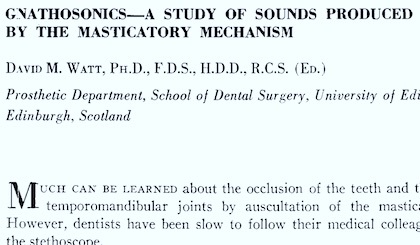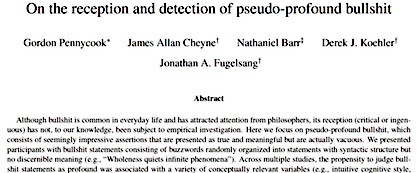Marc Abrahams's Blog, page 293
December 4, 2015
Getting to the bottom of the Swiss fondue paradox – philosophically
“
We review the history of the philosophy of fondue since Aristotle so as to arrive at the formulation of the paradox of Swiss fondue. Either the wine and the cheese cease to exist (Buridan), but then the fondue is not really a mixture of wine and cheese. Or the wine and the cheese continue to exist. If they do, then either they continue to exist in different places (the chemists), but then a fondue can never be perfectly homogenous (it is a French fondue). Or the wine and the cheese continue to exist in the same place (the Stoïcs), but then wine and cheese have to be, oddly, penetrable and spatially expansible.”
Philosophers Alain de Libera (Professor, Collège de France; Professor Emeritus of History of Medieval Philosophy, University of Geneva) and Olivier Massin (maître assistant at the Philosophy Department of the University of Geneva) examine the Swiss fondue paradox in their paper ‘Qu’est-ce qu’une fondue?’ [in French]. The team note that:
“Aristote attempted to solve this paradox by arguing that the cheese and wine continue to exist, but only potentially in the fondue. [see note below]“
– and go on to sketch an alternative answer, with reference to Aristotle’s ‘On Generation and Corruption’. The answer, which they sketch, is:
“The wine and the cheese continue to exist, but only non-spatially in the fondue. Wine and cheese, once mixed, become non-spatial constituents of the fondue, a bit like character traits are non-spatial constituents of persons. The wine and the cheese are in the fondue, but only the fondue is there in the fondue pot.”
Notes:
[1] Perplexingly, Improbable has not been able to locate any mention of either ‘cheese’ or ‘fondue’ in this renowned version of Aristotle’s ‘Generation and Corruption’, as translated by Professor Harold Henry Joachim and provided online by the University of Adeleide, Australia.
[2] The English translation of the paper’s abstract, as quoted above, is here.
Also see [cheese and paradox related] : Cheese solution to French Paradox?

December 3, 2015
“Why Do People (Not) Cough in Concerts?” (study)
“Concert etiquette demands that audiences of classical concerts avoid inept noises such as coughs.”
… and yet, explains Prof. Dr. Andreas Wagener (of the Institute of Social Policy at Leibniz Universität, Hannover, Germany) …
“ […] coughing in concerts occurs more frequently than elsewhere, implying a widespread and intentional breach of concert etiquette.”
Leading to the question ‘Why?’ Regarding which the professor presents an analysis in his paper ‘Why Do People (Not) Cough in Concerts? : The Economics of Concert Etiquette’ (Association for Cultural Economics International, Working Paper Series, 2012). However, although the study goes into considerable detail regarding the statistical probabilities of coughing (or not) …
“
Even at normal frequencies, coughs are concert-immanent: Assuming that each person coughs purely randomly, independently of everybody else’s coughing and at a time-invariant rate (homogeneous Poisson process), a normal frequency of 16 coughs per day corresponds to 0.0555 coughs in a five-minute interval. The likelihood that an individual will cough during a five-minute interval then is 1 – exp(- 0.05555) = 0.05404, and the probability that nobody in an audience of N people will cough during a five-minute interval equals (1 – 0.05404)N. For a small concert hall with N=200 people (the Golden Hall in Vienna’s Musikverein or New York’s Carnegie Hall seat well above 2,000 people), this amounts to 0.0015 percent, making the undisturbed performance even of a short piece of music extremely unlikely.“
… readers considering the paper’s conclusion …
“Listening to music evokes identity, prestige, exclusion, conformity, affirmation of values and shared aesthetic experiences. In classical music, both the norms of concert courtesy (not to cough, say) and individual disobedience to these rules (the deliberate cough) reflect these social phenomena.”
… may be left with a sense that there could still be room for further work studying the phenomenon in order to arrive at a definitive, determinate, conclusively unequivocal, full and final answer to the question posed in the title – viz. ‘Why?’
Note: Sadly, the Youtube® video clip cited in the paper, in which a piano-playing Bugs Bunny shoots a member of the audience who coughs during his rendition of Liszt’s Hungarian Rhapsody No. 2, is no longer available. Can any readers point to an online clip?
Further reading: Provided by Professor James W. Pennebaker, writing in the inaugural issue of Basic and Applied Social Psychology, 1980, ‘Perceptual and Environmental Determinants of Coughing’
“Unlike health-seeking behaviors and self-reported physical sensations, coughing is typically an immediate and observable response to the perception of a tickling or irritated throat. Several studies were conducted on coughing behavior in naturalistic classroom settings. The major findings include: (1) the larger the group, the more coughs per person;. (2) people are more likely to cough if they hear others cough; (3) the closer a person is to a cougher, the greater the probability that they will also emit a cough; (4) coughing varies as a function of external stimulus demands (i.e., when subjects viewed a movie that had previously been rated for its interest value every 30 seconds, subjects were more likely to cough during the uninteresting portions); and (5) high instructor evaluations were related to fewer coughs during lectures. Perceptual, physiological, and depth of processing issues as related to internal sensations arc discussed.”

December 2, 2015
Reflections on a urination duration peroration
Joe Stapleton went to a public talk by Ig Nobel physics prize winner David Hu. Here are Joe’s reflections on what he saw and heard:
BACKGROUND: The 2015 Ig Nobel prize for physics was awarded to Patricia Yang, David Hu, and Jonathan Pham, and Jerome Choo, for testing the biological principle that nearly all mammals empty their bladders in about 21 seconds (plus or minus 13 seconds). That research is described in the study “Duration of Urination Does Not Change With Body Size,” Patricia J. Yang, Jonathan Pham, Jerome Choo, and David L. Hu, Proceedings of the National Academy of Sciences, vol. 111 no. 33, August 19, 2014, pp. 11932–11937.

The man who years later drove to see another 1000-pound cheese
Cheese research, by an intrepid, longtime student of cheese. (Thanks to Adam K. Olson for bringing this to our attention.) Alison Mah reports, for the Ottowa Citizen:
Connecticut man drives seven hours to Ottawa to see one very large cheese
Anthony LoFrisco had been waiting almost 70 years to find another 1,000-pound provolone. He just didn’t think he’d have to make the seven hour, 673-kilometre drive from Wilton, Connecticut, to Ottawa to get it.
“It’s incredible beyond belief,” said LoFrisco, who arrived in Ottawa on Monday night with his son, Anthony Jr., to get a glimpse on Tuesday morning of the 1,000-pound provolone that came by boat from northern Italy and was delivered by truck to Nicastro’s Italian Food Emporium on Merivale Road. It took six men to unload it.
LoFrisco, a retired lawyer with a lifelong passion for cooking, put a halt on the publication of his Sicilian memoir-cookbook just to drive to Ottawa for the cutting of the provolone — a story he’ll include in his book….
BONUS: The poem “Ode on the Mammoth Cheese Weighing Over Seven Thousand Pounds“, by James McIntyre, the noted Canadian cheese poet, presented anew on a special occasion a few years ago.

Podcast #40: Sounds delicious, sounds disgusting, everything, and nothing
Delicious food sounds, disgusting food sounds (with special commentary on particular food sounds that disgust Professor Jean Berko Gleason), everything, and nothing — all of these turn up in this week’s Improbable Research podcast.
LISTEN TO IT! …or click on the “Venetian blinds” icon — at the lower right corner here — to select whichever week’s episode you want to hear:
SUBSCRIBE on Play.it, iTunes, or Spotify to get a new episode every week, free.
This week, Marc Abrahams tells about:
Sounds delicious. (Oliver Amft, Mathias Stäger, Paul Lukowicz, and Gerhard Tröster (2005). ‘Analysis of Chewing Sounds for Dietary Monitoring.’ UbiComp 2005: Proceedings of the 7th International Conference on Ubiquitous Computing, Tokyo, Japan, 11–14 September: 56–72. / Drake, B. K. (1963). ‘Food Crushing Sounds: An Introductory Study.’ Journal of Food Science 28 (2): 233–41. / Watt, D. M. (1966). ‘Gnathosonics: A Study of Sounds Producedby the Masticatory Mechanism.’ Journal of Prosthetic Dentistry 16 (1): 73–82. Featuring dramatic readings by Jean Berko Gleason.) Here’s detail from the gnathosonics paper:

Size, Timing, Everything, and Nothing. (“Size Is Everything,” Y. Arata, Nature Structural Biology, vol. 4, no. 2, February1997, pp. 93-4 / “Size Isn’t Everything,” D. Tyler and N.E. Baker, Bioessays, vol. 25, no. 1, January 2003, pp. 5-8. / “Timing Isn’t Everything,” S. Nelson, Neuron, vol. 26, no. 3, June 2000, pp. 545-6. / “Timing Is Everything,” K. Fox, Neuron, vol. 27, no. 1, July 2000, pp. 1-3. / “Do Everything,” R.A. Fronduti, Annals of Internal Medicine, vol. 121, no. 111, December 1994, pp. 900-1. / “Doing Nothing,” H.L. Fred, South Medical Journal, vol. 85, no. 4, April 1992, p. 343. / “When Does ‘Everything’ Mean Everything?” A. Rayo, Analysis, vol. 63, no. 278, April 2003, pp. 100-6. Featuring dramatic readings by Daniel Rosenberg.)
The mysterious John Schedler or the shadowy Bruce Petschek perhaps did the sound engineering this week.
The Improbable Research podcast is all about research that makes people LAUGH, then THINK — real research, about anything and everything, from everywhere —research that may be good or bad, important or trivial, valuable or worthless. CBS distributes it, on the CBS Play.it web site, and on iTunes and Spotify).

December 1, 2015
A Peculiar Bored Crinoid
This study about a bored crinoid is in fact about a peculiar bored crinoid:
“A peculiar bored crinoid from Salthill Quarry, Clitheroe, Lancashire (Mississippian; Tournaisian), UK,” S. K. Donovan and A. Tenny, Proceedings of the Yorkshire Geological Society, epub November 11, 2015. The authors, at Naturalis Biodiversity Center, Leiden, the Netherlands, and at the town of Rochdale, Lancashire, UK, report:
“The infestation of the live crinoid must be considered ectoparasitic.”
(Thanks to Tom Gill for bringing this to our attention.)

November 30, 2015
“Reception and Detection of Pseudo-Profound Bullshit”
Bullshit and academia continue their delighted dance. Behold a new study:
“On the Reception and Detection of Pseudo-Profound Bullshit,” Gordon Pennycook [pictured here], James Allan Cheyne, Nathaniel Barr, Derek J. Koehler, and Jonathan A. Fugelsang, Judgment and Decision Making, Vol. 10, No. 6, November 2015, pp. 549–563. The authors, at the University of Waterloo, explain:
‘Although bullshit is common in everyday life and has attracted attention from
philosophers, its reception (critical or ingenuous) has not, to our knowledge, been subject to empirical investigation. Here we focus on pseudo-profound bullshit, which consists of seemingly impressive assertions that are presented as true and meaningful but are actually vacuous. We presented participants with bullshit statements consisting of buzzwords randomly organized into statements with syntactic structure but no discernible meaning (e.g., “Wholeness quiets infinite phenomena”). Across multiple studies, the propensity to judge bullshit statements as profound was associated with a variety of conceptually relevant variables (e.g., intuitive cognitive style, supernatural belief). Parallel associations were less evident among profundity judgments for more conventionally profound (e.g., “A wet person does not fear the rain”) or mundane (e.g., “Newborn babies require constant attention”) statements. These results support the idea that some people are more receptive to this type of bullshit and that detecting it is not merely a matter of indiscriminate skepticism but rather a discernment of deceptive vagueness in otherwise impressive sounding claims.’
BONUS: Social Media and Bullshit
BONUS: Extending Bullshit Studies – more from Academia

Putting words into dogs’ mouths – ventriloquistically
 Professor Sirpa Leppänen of the Department of Languages, University of Jyväskylä, Finland, has a paper in Discourse, Context & Media (Volume 8, June 2015) about the ventriloquistic authentication of the human voice, as found in dog blogs.
Professor Sirpa Leppänen of the Department of Languages, University of Jyväskylä, Finland, has a paper in Discourse, Context & Media (Volume 8, June 2015) about the ventriloquistic authentication of the human voice, as found in dog blogs.
“It approaches dog blogs as an example of the strategic use of pervasive but contentious anthropomorphic western discourses about animals and discusses how dog bloggers use anthropomorphism as a discursive means for crafting and collectively ratifying authenticity in a translocal, interest-driven and informal social media context in which traditional territorial and demographic parameters of authenticity are not easily available or relevant.”
That’s to say, investigating the ways in which bloggers might put words into their dog’s mouth (so to speak). Given, as an example, is the ventriloquised voice of a US-based Tibetan Spaniel:
“Momma and I started obedience class last night. I am sorry to say that it was not our best showing. I am really scared of dogs I don’t know… and my cute little tail that is usually curled up on my back was tuck, tuck, tucked between my legs! Yikes! Those other dogs, even the little ones were FRIGHTENING! I did a lot of growling and made ‘wookie’ noises as momma calls them. (I guess I sound a lot like Chewbacca.)
Anyway, another dog had the audacity to lunge at me – well, I tell ya, I snapped at him!! I nearly bit his nose. Ha! That’ll show him!”
See: ‘Dog blogs as ventriloquism: Authentication of the human voice’ (a full copy of which may be found here:)
Bonus question [optional] Does your dog ‘speak’ – if so what does it say?

November 29, 2015
Tad Pfeffer joins the Luxuriant Facial Hair Club for Scientists (LFHCfS)
Tad Pfeffer has joined the Luxuriant Facial Hair Club for Scientists (LFHCfS). He says:
I have spent my ~40-year research career studying the mechanics of glaciers and ice sheets and their role in sea level change. For much of that time, I used to preface lectures and conference presentations with the observation that there is something intrinsically funny about being paid to run around on glaciers and think about how they work. Sea level rise isn’t as funny as it used to be, but the principle still stands. My membership in the LFHCfS is simply consistent with this philosophy and reinforces the long and time-honored tradition of scientists getting away with nonsense generally. (PS The headshot on my Jefferson Fellows page is an old one, and my beard there is nothing to write home to Mom about. Here, instead, is a Getty photo of me taken by Natalie Cass at the Sundance Film Festival.)
W.T. Pfeffer, Ph.D, LFHCfS
Professor, INSTAAR and
Dept. of Civil, Environmental, Architectural Engineering
University of Colorado at Boulder
Boulder, Colorado, USA


David Plonka joins the Luxuriant Flowing Hair Club for Scientists (LFHCfS)
David Plonka has joined the Luxuriant Flowing Hair Club for Scientists (LFHCfS). He says:
I am a research scientist and Internet researcher. My luxuriant flowing hair is as much the result of my hair-cutter leaving the employ of my barber shop many years ago (and my having not patronized any such establishment since) as it is the key element in an extended social experiment to determine what it takes for a scientist to be most often be referred to as “dude.” As such, it has most certainly improved my life.
David Plonka, Ph.D, LFHCfS
Research Scientist
Akamai Technologies
Cambridge, Massachusetts, USA


Marc Abrahams's Blog
- Marc Abrahams's profile
- 14 followers






